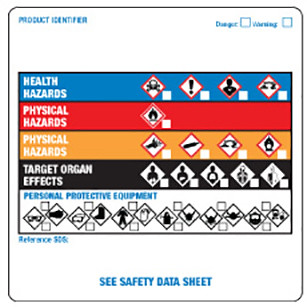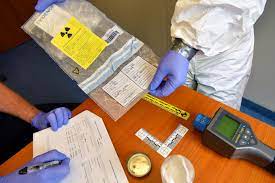
These Safety Data Sheets (SDS) look totally different! Health Canada requires the current MSDS to have a brand new format and include new data. This changes them from an MSDS to SDS. Click to learn extra. Our products are consumer products and are labeled in accordance with the Health Canada Consumer Chemicals and Containers Regulations, 2001 (CCCR). Our security data sheets (SDS) are ready in accordance with the WHMIS 2015 Regulations and comprise essential security data meant to protect employees who could use our products as a part of their job. While consumer chemicals do not require SDS in Canada, the WD-40 Company makes SDS available to users on our website to provide vital data on the protected use of our merchandise and to help employers in training their staff on how to make use of our merchandise safely. These SDS include the WHMIS/GHS hazard classification in Section 2 along with the labeling that might apply if these had been office hazardous chemicals. Employers utilizing our merchandise in their office should make a duplicate of the SDS accessible to their staff and practice their workers on the hazards these merchandise present. To help you in complying with these requirements and that will help you guarantee a secure workplace, we now have posted our SDS on this web site.
Use normal precautions appropriate for oily rags. Note: See STABILITY AND REACTIVITY (Section 10) for hazardous combustion and thermal decomposition data. Section 6: Accidental Release MEASURES Accidental Release Measures: Refer to other sections of this MSDS for info regarding bodily and well being hazards, respiratory SUPER PROFESSIONAL ANTIVIRAL DISINFECTANT SAFETY DATA SHEET, ventilation, and private protective gear. Call 3M-HELPS line ( ) for extra info on dealing with and managing the spill. Evacuate unprotected and untrained personnel from hazard space. The spill ought to be cleaned up by qualified personnel. Remove all ignition sources resembling flames, smoking supplies, and electrical spark sources. Use only nonsparking tools. Ventilate the realm with recent air. For large spill, or spills in confined spaces, provide mechanical ventilation to disperse or exhaust vapors, in accordance with good industrial hygiene follow. Warning! A motor might be an ignition source and will cause flammable gases or vapors within the spill area to burn or explode.

Keep away from heat, sparks, open flame, pilot lights and other sources of ignition. Ground containers securely when transferring contents. Wear low static or correctly grounded sneakers. Avoid respiration of vapors, mists or spray. Avoid eye contact with vapors, mists, or spray. Keep out of the reach of youngsters. Avoid contact with oxidizing agents. 7.2 STORAGE Store away from acids. Store away from heat. Store out of direct sunlight. Store away from oxidizing brokers. Section 8: Exposure CONTROLS/Personal Protection 8.1 ENGINEERING CONTROLS Use with acceptable local exhaust ventilation. 4 8.2 Personal Protective Equipment (PPE) Eye/Face Protection Avoid eye contact with vapors, mists, or spray. The next eye safety(s) are recommended: ZINC OXIDE SAFETY DATA SHEET Glasses with side shields Skin Protection Avoid skin contact. Select and use gloves and/or protective clothes to forestall skin contact based on the outcomes of an exposure evaluation. Consult with your glove and/or protective clothing manufacturer for collection of applicable appropriate materials. Gloves made from the following material(s) are really useful: Butyl Rubber, Neoprene, Nitrile Rubber Respiratory Protection Avoid breathing of vapors, mists or spray. Select one of the following NIOSH approved respirators based mostly on airborne concentration of contaminants and in accordance with OSHA laws: Half facepiece or fullface air-purifying respirator with organic vapor cartridges. Consult the present 3M Respiratory Selection Guide for additional data or call for 3M technical assistance Prevention of Swallowing Don't eat, drink or smoke when utilizing this product. Wash exposed areas completely with soap and water.
Closed containers exposed to heat from fireplace could build pressure and explode. Vapors may journey lengthy distances alongside the bottom or flooring to an ignition supply and flash again. May cause allergic pores and skin response. 2 Moderate Eye Irritation: Signs/signs could embrace redness, swelling, ache, tearing, and blurred or hazy imaginative and prescient. Skin Contact: Moderate Skin Irritation: Signs/signs may include localized redness, swelling, itching, and dryness. Prolonged or repeated exposure could trigger: Allergic Skin Reaction (non-picture induced): Signs/signs could embody redness, swelling, blistering, and itching. Inhalation: Respiratory Tract Irritation: Signs/symptoms might embody cough, sneezing, nasal discharge, headache, hoarseness, and nostril and throat ache. Ingestion: Gastrointestinal Irritation: Signs/symptoms may embody abdominal ache, stomach upset, nausea, vomiting and diarrhea. Section 4: FIRST Aid MEASURES 4.1 FIRST Aid PROCEDURES The following first aid recommendations are based on an assumption that appropriate personal and industrial hygiene practices are followed. Eye Contact: Flush eyes with giant quantities of water.
Contain spill. For larger spills, cowl drains and build dikes to stop entry into sewer programs or bodies of water. Cover or dilute with water. Working from across the edges of the spill inward, cover with bentonite, vermiculite, or commercially available inorganic absorbent materials. Mix in adequate absorbent until it seems dry. Remember, including an absorbent material does not remove a toxic, corrosivity or flammability hazard. Collect as much of the spilled materials as doable using non-sparking tools. Clean up residue with detergent and water. If you cherished this article and you would like to be given more info with regards to 3M MATERIAL SAFETY DATA SHEET generously visit our web page. Collect the resulting residue containing resolution. Place in a steel container accredited for transportation by appropriate authorities. Seal the container. Dispose of collected materials as soon as attainable. Within the event of a release of this materials, the person should decide if the discharge qualifies as reportable in line with local, state, and federal rules. Section 7: Handling AND STORAGE 7.1 Handling Do not eat, drink or smoke when utilizing this product. Wash exposed areas completely with soap and water.